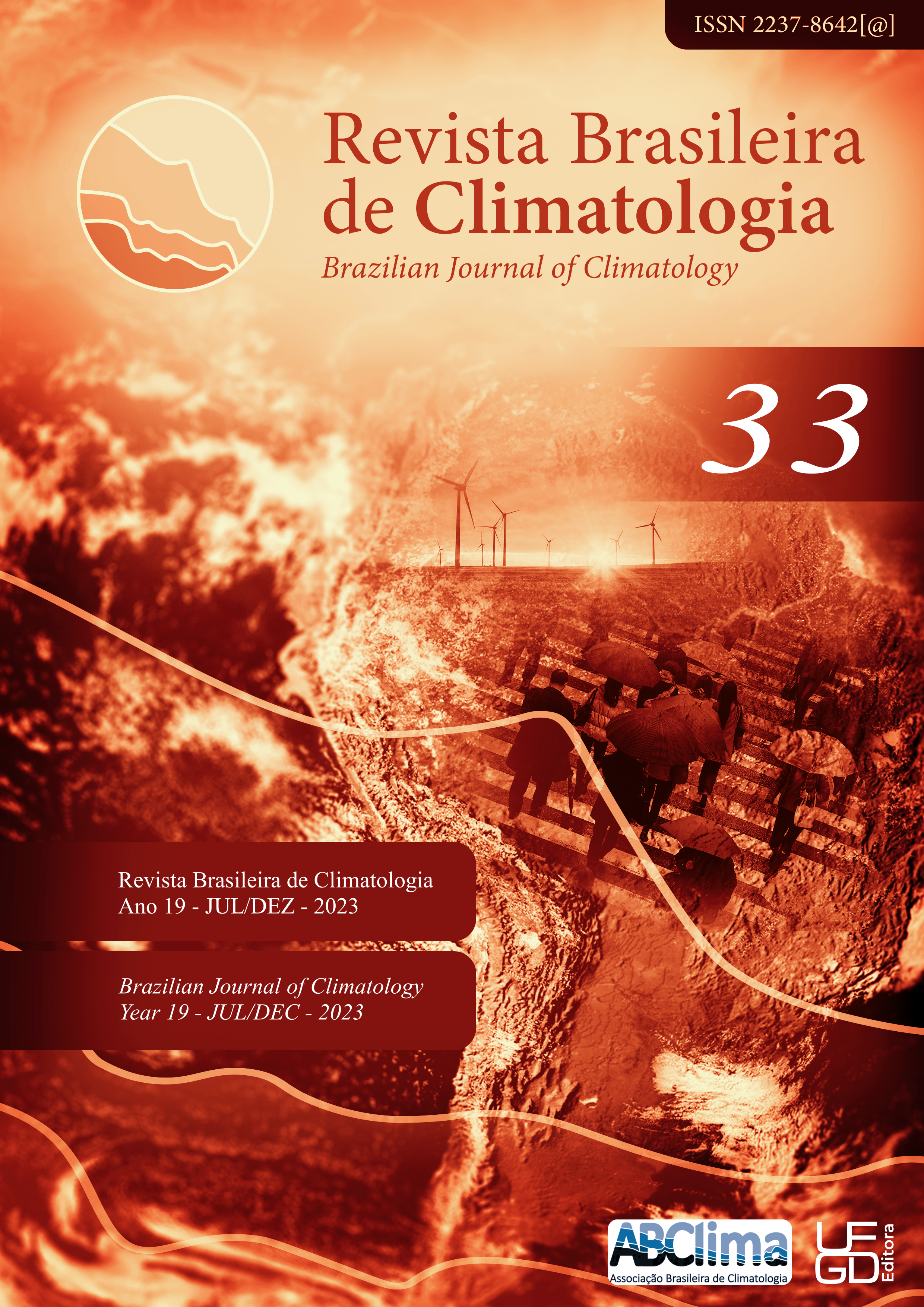Daily thermal range: characterization of the type of distribution and estimation of values in the upper percentiles
DOI:
https://doi.org/10.55761/abclima.v33i19.16520Keywords:
Daily temperature ranges., Estimation of temperature ranges., Passive buildings.Abstract
Designing passive buildings that present adequate thermal environments for human activities requires knowing aspects of the climate in which these buildings will be installed. Among these aspects are the daily thermal ranges (DTR). Knowing the DTR makes it possible to more accurately specify the envelope, the internal elements and the shape of the building. However, in Brazil, little is known about DTR. There are few localities for which DTRs are published. Therefore, this research aimed to better understand this variable and verify the existence of patterns in its distribution. Secondarily, it aimed to propose and evaluate methods for estimating daily temperature ranges in different percentiles. To achieve these goals, data from 153 locations in the state of Santa Catarina, a region with varied climatic contexts, were analyzed. The analysis pointed out that the daily temperature ranges have a normal distribution and that it is possible to make estimates for the upper percentiles for a location based on its annual average. Three methods for estimating at different percentiles have been proposed. The application of the methods to 44 locations in the state of Rio Grande do Sul indicated that the three presented satisfactory results for percentiles between 70 and 99.
Downloads
References
ASSOCIAÇÃO BRASILEIRA DE NORMAS TÉCNICAS (ABNT). NBR 15.220: Desempenho térmico de edificações. Parte 3: Zoneamento bioclimático brasileiro e diretrizes construtivas para habitações unifamiliares de interesse social. Brasil, Rio de Janeiro, 2005. p. 23.
CHENG, J. et al. Impact of diurnal temperature range on human health: a systematic review. International Journal of Biometeorology, v. 58, n. 9, p. 2011–2024, 2014. DOI: https://doi.org/10.1007/s00484-014-0797-5
DINIZ, F. de A.; RAMOS, A. M.; REBELLO, E. R. G. Normais Climatológicas do Brasil, Período 1982-2010. Brasília: INMET, 2014.
EVANS, J. M. Evaluating comfort with varying temperatures: a graphic design tool. Energy and Buildings, v. 35, p. 87–93, 2003. DOI: https://doi.org/10.1016/S0378-7788(02)00083-X
FERNANDES, L. C. Diagramas de apoio ao projeto baseados na ideia do conforto térmico adaptativo. PARC Pesquisa em Arquitetura e Construção, v. 11, n. 1, 2020. DOI: https://doi.org/10.20396/parc.v11i0.8657295
GIVONI, B. Comfort, climate analysis and building design guidelines. Energy and Buildings, v. 18, n. 1, p. 11–23, 1992. DOI: https://doi.org/10.1016/0378-7788(92)90047-K
GOULART, S. V. G.; LAMBERTS, R.; FIRMINO, S. Dados Climáticos para Projeto e Avaliação Energética de Edificações para 14 Cidades Brasileiras. 2. ed. Florianópolis: Núcleo de Pesquisa em Construção/UFSC, 1998.
HUANG, K. et al. Short-term effect of ambient temperature change on the risk of tuberculosis admissions: Assessments of two exposure metrics. Environmental Research, v. 189, p. 109900, 2020. DOI: https://doi.org/10.1016/j.envres.2020.109900
KOENIGSBERGER, O. H. et al. Manual of Tropical Housing and Building, Orient Blackswan private Limited, 1973.
KRÜGER, E. L. et al. Proposition of a simplified method for predicting hourly indoor temperatures in test cells. Ambiente Construído, v. 17, n. 3, p. 57–70, 2017. DOI: https://doi.org/10.1590/s1678-86212017000300162
LANDAU, E. C. et al. Geoespacialização da amplitude térmica no Brasil. In: III SIMPÓSIO INTERNACIONAL DE CLIMATOLOGIA: MUDANÇAS DE CLIMA E EXTREMOS E AVALIAÇÃO DE RISCOS FUTUROS, PLANEJAMENTO E DESENVOLVIMENTO SUSTENTÁVEL 2009a, Canela. Anais... Canela: Sociedade Brasileira de Meteorologia (SBMET), 2009a.
LANDAU, E. C. et al. Tendências de variação da amplitude térmica no brasil em função das mudanças climáticas. In: III SIMPÓSIO INTERNNACIOAL DE CLIMATOLOGIA: MUDANÇAS DE CLIMA E EXTREMOS E AVALIAÇÃO DE RISCOS FUTUROS, PLANEJAMENTO E DESENVOLVIMENTO SUSTENTÁVEL 2009b, Canela. Anais... Canela: Sociedade Brasileira de Meteorologia (SBMET), 2009b.
MA, Y. et al. Effects of temperature variation and humidity on the death of COVID-19 in Wuhan, China. Science of the Total Environment, v. 724, 2020. DOI: https://doi.org/10.1016/j.scitotenv.2020.138226
OLGYAY, V. Bioclimatic orientation method for buildings. International Journal of Biometeorology, v. 11, n. 2, p. 163–174, 1967. DOI: https://doi.org/10.1007/BF01426843
OLGYAY, V. Arquitectura y Clima. Manual de diseño bioclimático para arquitectos y urbanistas. Barcelona: Gustavo Gili, 2008.
SILVA, C. S. da.; PINTO, S. S. Estatística: volume II. Rio Grande: Ed. da FURG, 2021.
VERBEKE, S.; AUDENAERT, A. Thermal inertia in buildings: A review of impacts across climate and building use. Renewable and Sustainable Energy Reviews, v. 82, n. November 2016, p. 2300–2318, 2018. DOI: https://doi.org/10.1016/j.rser.2017.08.083
XU, Z. et al. Diurnal temperature range and childhood asthma: A time-series study. Environmental Health: A Global Access Science Source, v. 12, n. 1, p. 1–5, 2013. DOI: https://doi.org/10.1186/1476-069X-12-12
Downloads
Published
How to Cite
Issue
Section
License
A aprovação dos artigos implica a aceitação imediata e sem ônus de que a Revista Brasileira de Climatologia terá exclusividade na primeira publicação do artigo. Os autores continuarão, não obstante, a deter os direitos autorais. Os autores autorizam também que seus artigos sejam disponibilizados em todos os indexadores aos quais a revista está vinculada.
Os autores mantém seus direitos de publicação sem restrições
A Comissão Editorial não se responsabiliza pelos conceitos ou afirmações expressos nos trabalhos publicados, que são de inteira responsabilidade dos autores.
A Revista Brasileira de Climatologia oferece acesso livre imediato ao seu conteúdo, seguindo o entendimento de que disponibilizar gratuitamente o conhecimento científico ao público proporciona maior democratização do conhecimento e tende a produzir maior impacto dos artigos publicados. Os artigos publicados na revista são disponibilizados segundo a Licença Creative Commons CC-BY-NC 4.0 (https://creativecommons.org/licenses/by-nc/4.0/). Segundo essa licença é permitido acessar, distribuir e reutilizar os artigos para fins não comerciais desde que citados os autores e a fonte. Ao submeter artigos à Revista Brasileira de Climatologia, os autores concordam em tornar seus textos legalmente disponíveis segundo essa licença




